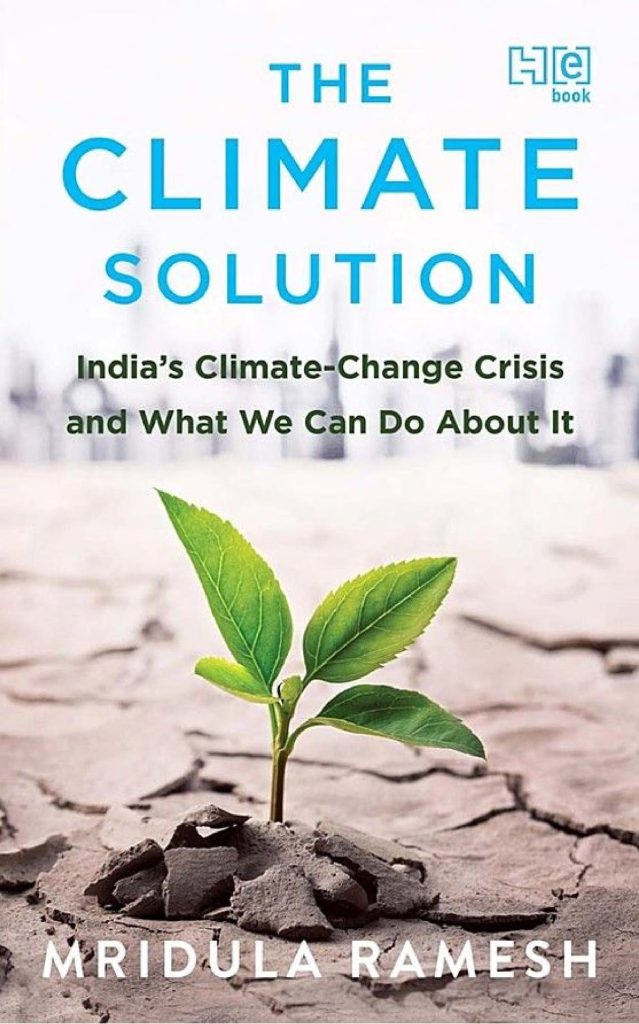Book Summary by Pradeep Nair
The Climate Solution: India’s Climate Change Crisis and What We Can Do About It
“It was a dusty morning in Hyderabad in April 2016,” the author narrates in Chapter 4 of The Climate Solution. On that hot summer day, a construction worker prepares to go to work as usual. The Andhra Pradesh government had issued an advisory asking people to stay indoors. “If we don’t work, we can’t earn our living,” the worker tells a TV channel, and starts his auto to begin the day. Lessthan twelve hours later, he was dead, unable to cope with the heat.
Killer heatwaves and other extreme weather events point to the ticking climate clock and, as Mridula Ramesh points out, “experts believe India to be the country most vulnerable to climate change”. Thisbook is a call to action to combat climate change.
The author starts with the dedication line, ‘For my children’, and goes on to warn that “time is running out for humanity to avoid dangerous warming – the kind that would see 40 million migrate across the Indian subcontinent as their homes become unliveable.” In the Prologue, she narrates her experience of the devastating December 2015 Chennai floods, “in which hundreds lost their lives” and “hundreds of thousands lost their homes”.“This is what a climate-changed world would look like,” she warns.
An environmental activist, educator and angel investor in clean tech start-ups, Ramesh conveys that “the situation is grim, but there is still hope”. And, as the title suggests, it needs solutions and effort – individual and collective.
Giving a peek into the past, taking realistic stock of the present, and offering solutions for a climatesecure India, the book is in two parts – one states the problem and the other offers solutions.
The first part, in eight chapters, explains how India is impacted by global climate change and how rising temperatures, unpredictable rainfall patterns, floods, and other extreme weather events are impacting farming, health, livelihoods, and even mental health and national security. However, India’s case is not discussed in isolation. The author details the global politics behind international climate mitigation deals and how India’s environmental challenges are linked to it, or not linked to it, given the local factors behind environmental problems in India. “The cruel twist,” she notes, “is that India suffers acutely from the effects of climate change while not contributing substantially to the problem…. India contributes only about 6 per cent to global carbon emissions.” For those uninitiated on the science of climate change and global mitigation efforts, the book explains the mechanics and impact of CO2 emissions, and the five reports of the Intergovernmental Panel on Climate Change (IPCC) up to 2014 that led to the landmark 2015 Paris Climate Agreement, a legally binding international treaty to limit global warming to 1.5 degrees Celsius above pre- industrial levels. However, Ramesh highlights the general ignorance of terms like global warming, as a 2012 survey showed 41 per cent of Indians were ignorant of global warming. She notes that while the “IPCC represents the gold standard for climate-change research, their “reports are difficult reads… harder to read than the physics papers published by Albert Einstein and Stephen Hawking.” While part one explains the ‘why’, part two is about the ‘how to act’. Managing resources of water, food, energy and waste is suggested as the way forward. Ramesh spotlights how technological innovation can help manage water, food, energy and waste, of which water is a cause of disputes between states and needs addressing. “Supercharging India’s innovation ecosystem and getting start-ups to focus on climate resilience is one of the strongest weapons in our arsenal,” she says.
As the founder of Sundaram Climate Institute, which works on waste and water solutions and education, Ramesh practices what she preaches – she lives in a net zero-waste home with her husband and two children, in Madurai, Tamil Nadu. According to her, “managing waste well is one of the strongest adaptive actions we can take in a warming climate” and cites estimates that “four tofive ‘new’ jobs can be created per tonne of managed waste.”
The book appeals to three groups: policymakers, institutional leaders, and concerned citizens, and explains climate challenges and potential solutions for both urban and rural India. There are chapters titled Food for Thought (Ch. 16) and Vision India 2025 (Ch. 17). The chapter ‘Climate Heroes’ narrates the stories of “heroes” who have revived rivers, doubled small farmers’ crop yields, helped manage urban waste, and grown mangoes in the desert. She says they need to be cheered. Ramesh discusses in minute detail the far-reaching impact of a warming climate on women, who are already at the receiving end of wage disparity and other social problems. For instance, she says that as drought incidents increase, girls will have to walk longer distances for water, thus stealing their school and leisure time. The book concludes with a checklist of actions for individuals, institutions and the government.
A thought-provoking read in times of climate uncertainty! Supplement it with the reading of PIC’s own policy paper, India in the Climate Challenged World, and more on the topic in PIC’s Policy Papers section.
(Pradeep Nair is Senior Editor at Pune International Centre.)


